Science (English Medium)
Academic Year: 2023-2024
Date & Time: 19th March 2024, 10:30 am
Duration: 3h
Advertisements
General Instructions:
Read the following instructions carefully and follow them:
- This question paper contains 33 questions. All questions are compulsory.
- Question paper is divided into FIVE sections - Section A, B, C, D and E.
- Section A - question number 1 to 16 are multiple choice type questions. Each question carries 1 mark.
- Section B - question number 17 to 21 are very short answer type questions. Each question carries 2 marks.
- Section C - question number 22 to 28 are short answer type questions. Each question carries 3 marks.
- Section D - question number 29 and 30 are case-based questions. Each question carries 4 marks. Each question has subparts with internal choice in one of the subparts.
- Section E - question number 31 to 33 are long answer type questions. Each question carries 5 marks.
- There is no overall choice. However, an internal choice has been provided in section B, C and D of question paper. A candidate has to write answer for only one of the alternatives in such questions.
- Kindly note that there is a separate question paper for Visually Impaired candidates.
- Wherever necessary, neat and properly labelled diagrams should be drawn.
A single gene that controls the expression of more than one trait is said to show ______.
Multiple allelism
Polygenic inheritance
Incomplete dominance
Pleiotropism
Chapter:
A person with trisomy of 21st chromosome shows ______.
- Furrowed tongue
- Characteristic palm crease
- Rudimentary ovaries
- Gynaecomastia
Select the correct option, from the choices given below:
ii and iv
i, ii and iv
ii and iii
i and iii
Chapter:
Observe the schematic representation of assisted reproductive technology given below:
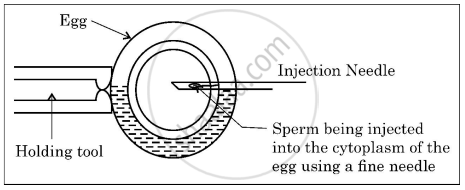
Identify the most appropriate technique depicted in the above diagram.
IUT
IUI
ICSI
ZIFT
Chapter:
Interferons are proteins secreted by ______.
RBC
WBC
Bacteria infected cell
Virus infected cell
Chapter:
During biological treatment of sewage, the masses of bacteria held together by fungal filaments to form mesh like structures are called ______.
primary sludge
flocs
activated sludge
anaerobic sludge
Chapter:
Which one of the following statements is correct in the context of observing DNA separation by agarose gel electrophoresis?
DNA can be seen in visible light.
DNA can be seen without staining in visible light.
Ethidium bromide stained DNA can be seen in visible light
Ethidium bromide stained DNA can be seen under UV light.
Chapter:
A phenomenon where a male insect mistakenly identified the patterns of a orchid flower as the female insect partner, and tries to copulate and thereby pollinates the flower is said to be ______.
Pseudocopulation
Pseudopollination
Pseudoparthenocarpy
Pseudofertilisation
Chapter:
Identify the correct labellings in the figure of a fertilised embryo sac of an angiosperm given below:
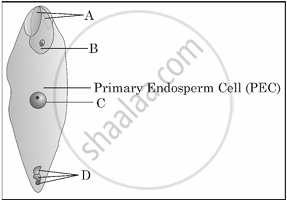
A - zygote, B - degenerating synergids, C - degenerating antipodals, D - PEN
A - degenerating synergids, B - zygote, C - PEN, D - degenerating antipodals
A - degenerating antipodals, B - PEN, C - degenerating synergids, D - zygote
A - degenerating synergids, B - zygote, C - degenerating antipodals, D - PEN
Chapter:
Study the pedigree chart of a family showing the inheritance pattern of a certain disorder. Select the option that correctly identifies the nature of the trait depicted in the pedigree chart.
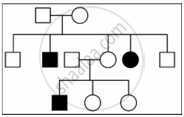
Dominant X - linked
Recessive X - linked
Autosomal dominant
Autosomal recessive
Chapter:
Match the following genes of the lac operon listed in column ‘A’ with their respective products listed in column ‘B’:
| A Gene |
B Products |
||
| a. | ‘i’ gene | (i) | β-galactosidase |
| b. | ‘z’ gene | (ii) | lac permease |
| c. | ‘a’ gene | (iii) | repressor |
| d. | ‘y’ gene | (iv) | transacetylase |
Select the correct option:
a - (i), b - (iii), c - (ii), d - (iv)
a - (iii), b - (i), c - (ii), d - (iv)
a - (iii), b - (i), c - (iv), d - (ii)
a - (iii), b - (iv), c - (i), d - (ii)
Chapter:
If both the parents are carriers for thalassaemia, the chances of an afflicted child to be born to them is ______.
25%
50%
75%
100%
Chapter:
If the sequence of nitrogen bases of the coding strand of DNA in a transcription unit is 5' - ATGAATG - 3' the sequence of bases in its RNA transcript would be ______.
5' - AUGAAUG - 3'
5' - UACUUAC - 3'
5' - CAUUCAU - 3'
5' - GUAAGUA - 3'
Chapter: [0.05] Molecular Basis of Inheritance
Assertion (A): AIDS is a syndrome caused by HIV.
Reason (R): HIV is a virus that damages the immune system with DNA as its genetic material.
Both (A) and (R) are true and (R) is the correct explanation of (A).
Both (A) and (R) are true, but (R) is not the correct explanation of (A).
(A) is true, but (R) is false.
(A) is false, but (R) is true.
Chapter:
Assertion (A): In molecular diagnosis, single stranded DNA or RNA tagged with radioactive molecule is called a probe.
Reason (R): A probe always searches and hybridises with its complementary DNA in a clone of cells.
Both (A) and (R) are true and (R) is the correct explanation of (A).
Both (A) and (R) are true, but (R) is not the correct explanation of (A).
(A) is true, but (R) is false.
(A) is false, but (R) is true.
Chapter:
Assertion (A): In birds the sex of the offspring is determined by males.
Reason (R): Males are homogametic while females are heterogametic.
Both (A) and (R) are true and (R) is the correct explanation of (A).
Both (A) and (R) are true, but (R) is not the correct explanation of (A).
(A) is true, but (R) is false.
(A) is false, but (R) is true.
Chapter:
Assertion (A): Communities that comprise of more species tend to be more stable.
Reason (R): A higher number of species results in less year to year variation in total biomass.
Both (A) and (R) are true and (R) is the correct explanation of (A).
Both (A) and (R) are true, but (R) is not the correct explanation of (A).
(A) is true, but (R) is false.
(A) is false, but (R) is true.
Chapter:
“Farmers prefer apomictic seeds to hybrid seeds.” Justify giving two reasons.
Chapter:
Advertisements
5' – G ↓ A A T T C - 3'
3' – C T T A A ↑ G - 5'
- Name the restriction enzyme that recognises the given specific sequence of bases. What are such sequence of bases referred to as?
- What are the arrows in the given figure indicating? Write the result obtained thereafter.
Chapter:
Observe the population growth curve and answer the questions given below:
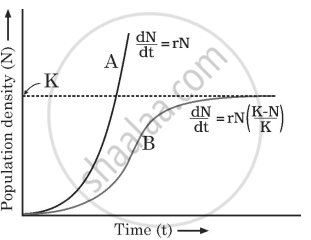
- State the conditions under which growth curve ‘A’ and growth curve ‘B’ plotted in the graph are possible.
- Mention what does ‘K’ in the graph represent.
Chapter:
Explain how are plants benefitted by their association with “Glomus species”.
Chapter:
If the base adenine constitutes 31% of an isolated DNA fragment, then write what will be the expected percentage of the base cytosine in it. Explain how did you arrive at the answer given.
Chapter:
Identify a, b, c, d, e and f in the table given below:
| Sl. No. | Organism | Bioactive Molecule | Use |
| 1. | Monascus purpureus | a | b |
| 2. | c | d | Antibiotic |
| 3. | e | Cyclosporin A | f |
Chapter:
Tropical regions harbour more species than the temperate regions. How have biologists tried to explain this in their own ways? Explain.
Chapter:
The Ecological pyramids may have an ‘upright’ or an ‘inverted’ shape. Justify with the help of suitable examples.
Chapter:
- What are transgenic animals?
- Name the transgenic animal having the largest number amongst all the existing transgenic animals.
- State any 3 reasons for which these types of animals are being produced.
Chapter:
If the cells in the leaves of a maize plant contain 10 chromosomes each, write the number of chromosomes in its endosperm and zygote. Name and explain the process by which an endosperm and a zygote are formed in maize.
Chapter:
Why does DNA replication occur within a replication fork and not in its entire length simultaneously?
Chapter:
“DNA replication is continuous and discontinuous on the two strands within the replication fork.” Explain with the help of a schematic representation.
Chapter:
Explain the process of making heterogeneous nuclear RNA (hnRNA) into a fully functional mRNA in eukaryotes. Where does this process occur in the cell?
Chapter: [0.05] Molecular Basis of Inheritance
The world is facing accelerated rates of species extinction largely due to human activities. Explain any three human activities responsible for accelerated rates of species extinction.
Chapter:
In a human female, the reproductive phase starts on the onset of puberty and ceases around middle age of the female. Study the graph given below regarding menstrual cycle and answer the questions that follow:

(a) Name the hormones and their source organ, which are responsible for menstrual cycle at puberty. [1]
(b) For successful pregnancy, at what phase of the menstrual cycle an early embryo (upto 3 blastomeres) should be Implanted in the Uterus (IUT) of a human female who has opted for Assisted Reproductive Technology (ART)? Support your answer with a reason. [1]
(c) Name the hormone and its source organ responsible for the events occurring during proliferative phase of menstrual cycle. Explain the event. [2]
OR
(c) In a normal human female, why does menstruation only occurs if the released ovum is not fertilised? Explain. [2]
Chapter:
Read the following passage and answer the questions that follow:
| “Mosquitoes are drastically affecting the human health in almost all the developing tropical countries. Different species of mosquitoes cause very fatal diseases so much so that many humans loose their life and if they survive, are unable to put in productive hours to sustain their life. With the result the health index of the country goes down.” |
(a) Name the form in which Plasmodium gains entry into
- human body
- the female Anopheles body. [1]
(b) Why do the symptoms of malaria not appear in a person immediately after being bitten by an infected female Anopheles? Give one reason. Explain when and how do the symptoms of the disease would appear. [2]
OR
(b) Explain the events which occur within a female Anopheles mosquito after it has sucked blood from a malaria patient. [2]
(c) Name a species of mosquito other than female Anopheles and the disease, for which it carries the pathogen. [1]
Chapter:
Advertisements
Draw a schematic diagram of the cloning vector pBR 322 and label
- Bam HI site
- gene for ampicillin resistance
- ‘ori’
- ‘rop’ gene.
Chapter:
A cloning vector does not have a selectable marker. How will it affect the process of cloning?
Chapter:
Why is insertional inactivation preferred over the use of selectable markers in cloning vectors?
Chapter:
Name the nematode (scientific name) that infects the roots of tobacco plant and reduces its yield.
Chapter:
Name the vector that is used to introduce nematode-specific genes into the host plant (tobacco).
Chapter:
Why could parasite not survive in a transgenic tobacco plant?
Chapter:
Draw a diagram of a human sperm. Label any four parts and write their functions.
Chapter:
In a human female, probability of an ovum to get fertilized by more than one sperm is impossible. Give reason.
Chapter:
With the help of labelled diagram only, show the different stages of embryo development in a dicot plant.
Chapter:
Endosperm development precedes embryo development. Justify.
Chapter:
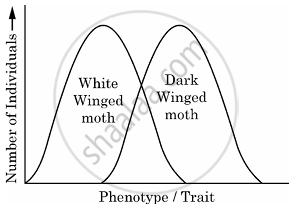
Natural selection operates in different ways in nature.
- Identify the type of natural selection depicted in the graph above. [1]
- In England after industrialisation, the population of dark winged moths were more favoured than white winged moth. Explain. [2]
- Anthropogenic action can enhance the rate of evolution. Explain with the help of an example. [2]
Chapter:
- Why did Hershey and Chase use ‘35S’ and ‘32P’ in their experiment? Explain. [1]
- State the importance of
- blending and [1]
- centrifugation in their experiment. [1]
- Write the conclusion they arrived at the end of their experiment. [2]
Chapter:
Other Solutions
Submit Question Paper
Help us maintain new question papers on Shaalaa.com, so we can continue to help studentsonly jpg, png and pdf files
CBSE previous year question papers Class 12 Biology with solutions 2023 - 2024
Previous year Question paper for CBSE Class 12 -2024 is solved by experts. Solved question papers gives you the chance to check yourself after your mock test.
By referring the question paper Solutions for Biology, you can scale your preparation level and work on your weak areas. It will also help the candidates in developing the time-management skills. Practice makes perfect, and there is no better way to practice than to attempt previous year question paper solutions of CBSE Class 12.
How CBSE Class 12 Question Paper solutions Help Students ?
• Question paper solutions for Biology will helps students to prepare for exam.
• Question paper with answer will boost students confidence in exam time and also give you an idea About the important questions and topics to be prepared for the board exam.
• For finding solution of question papers no need to refer so multiple sources like textbook or guides.
